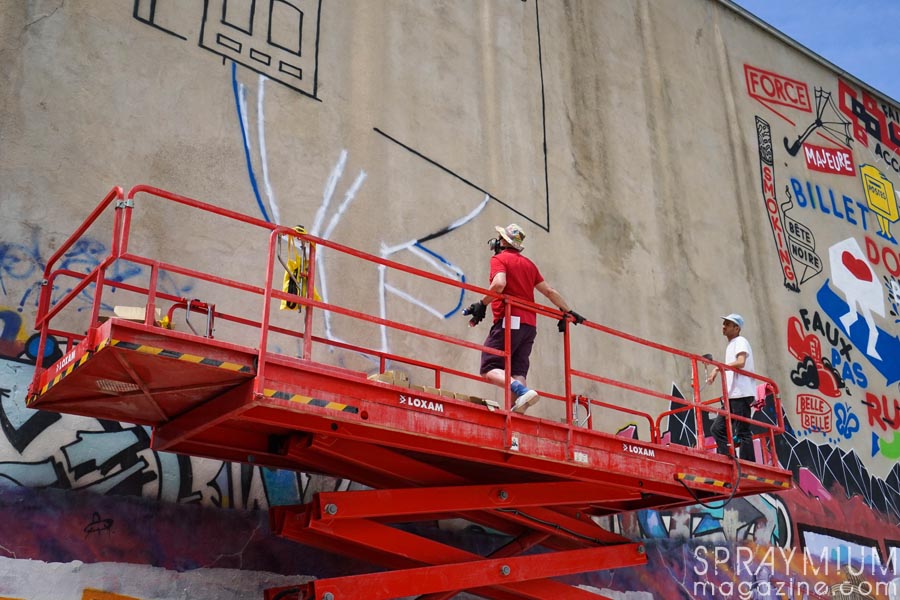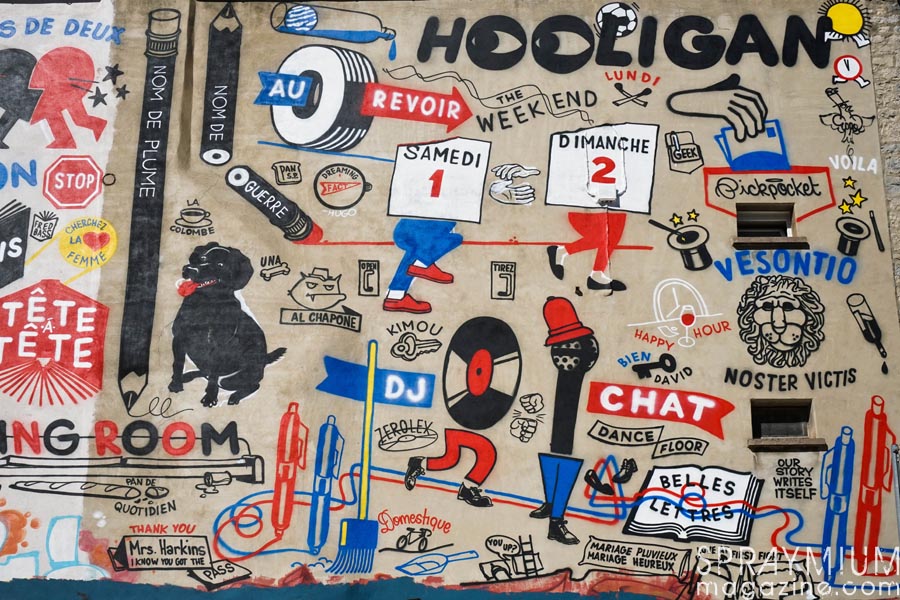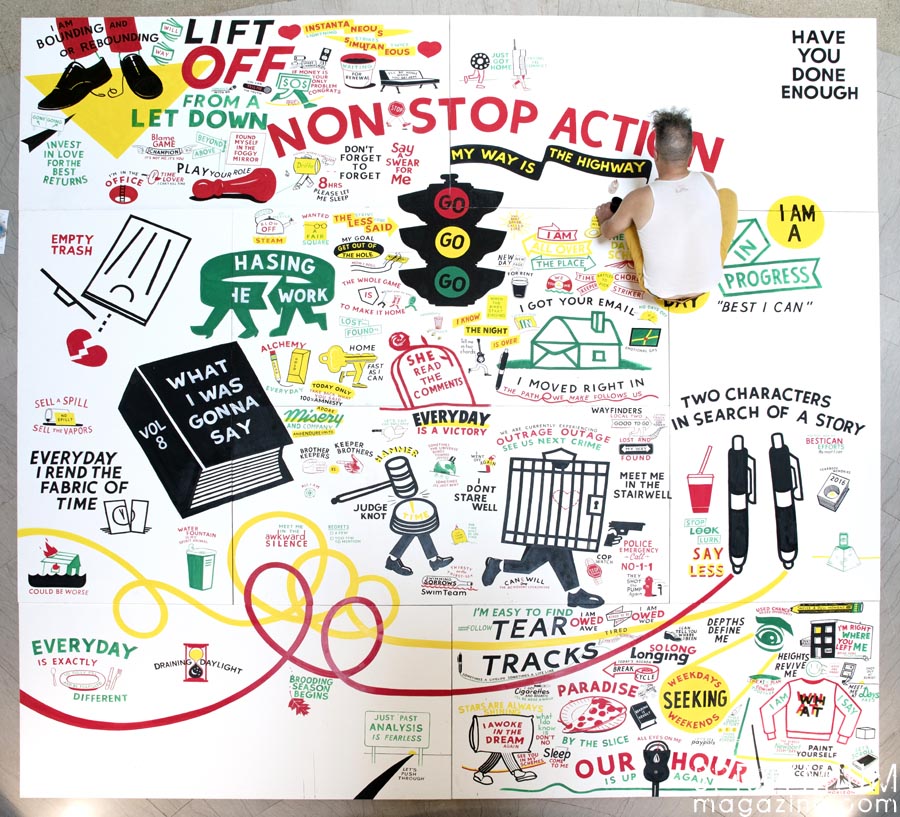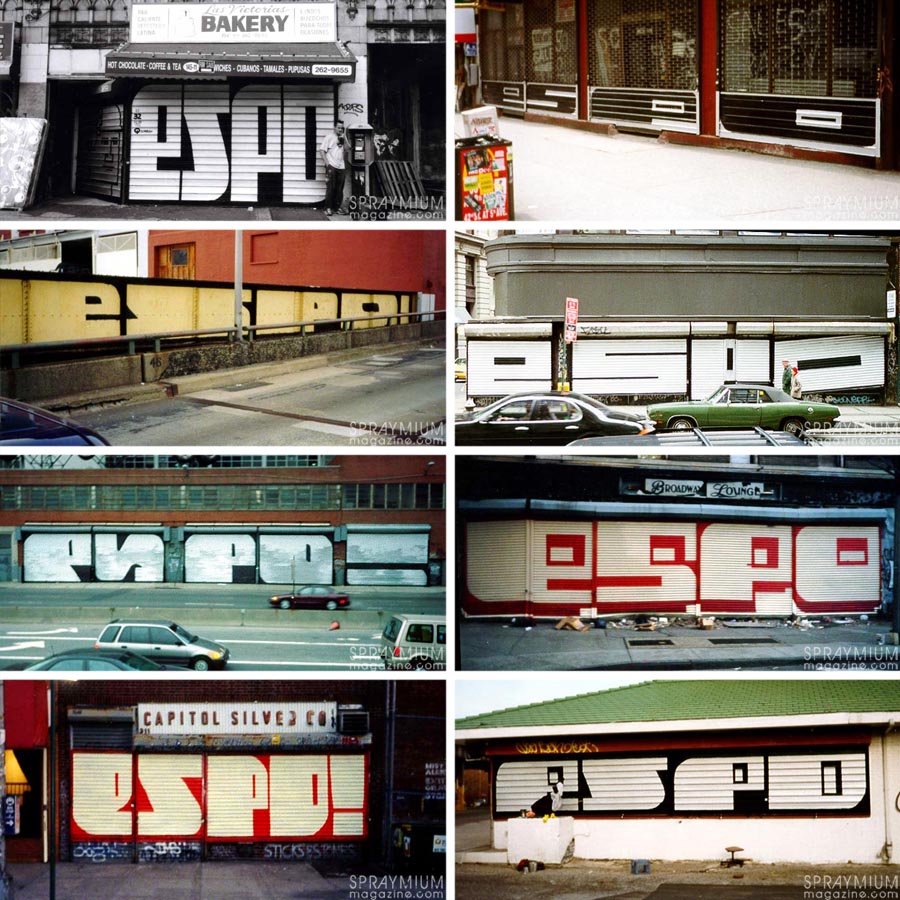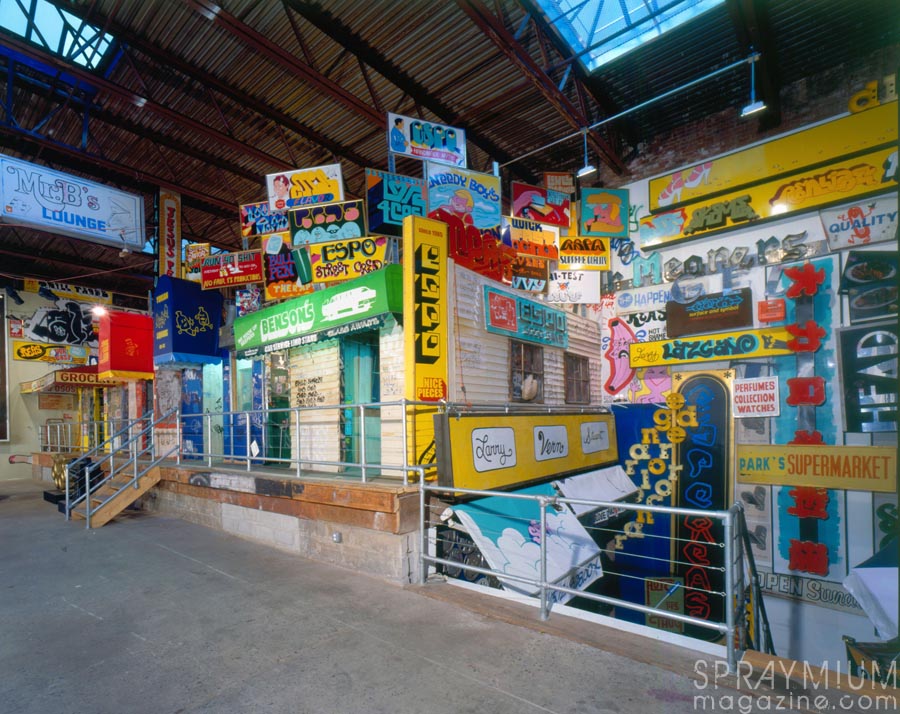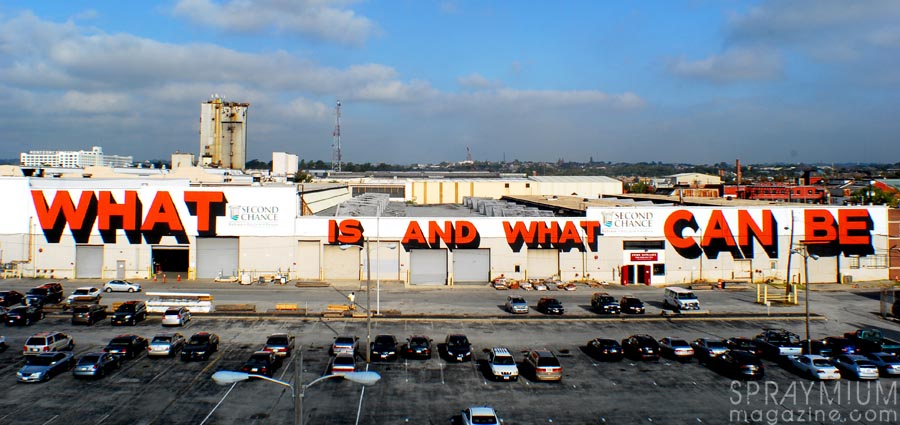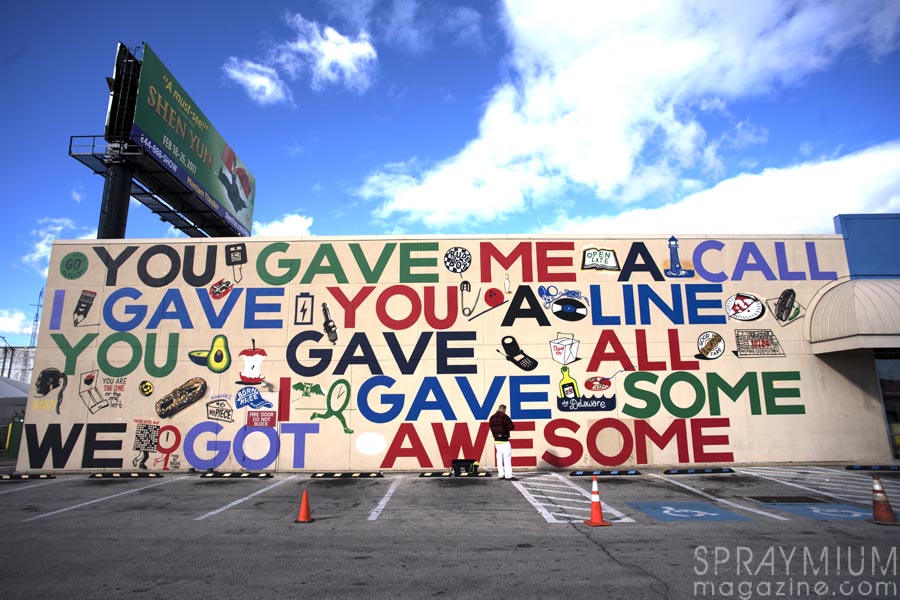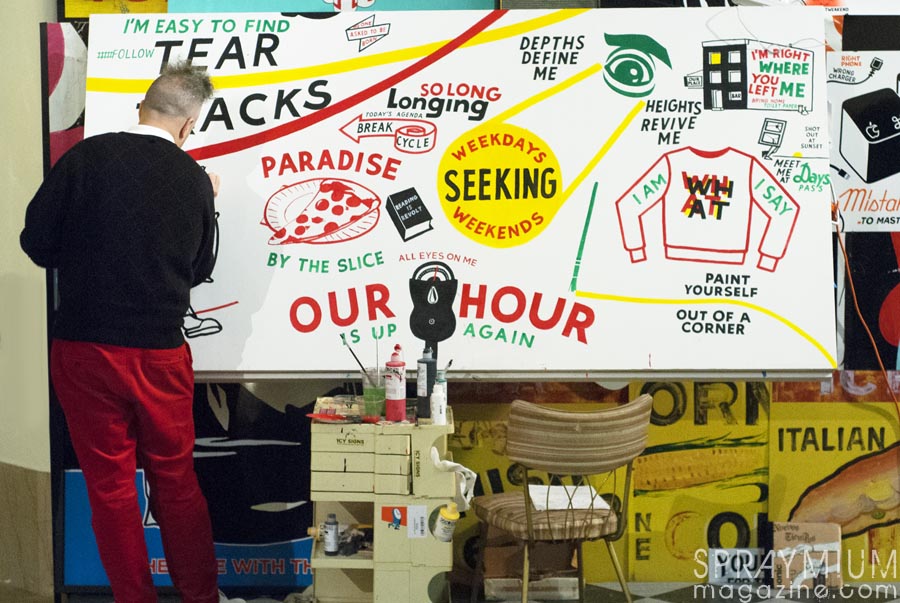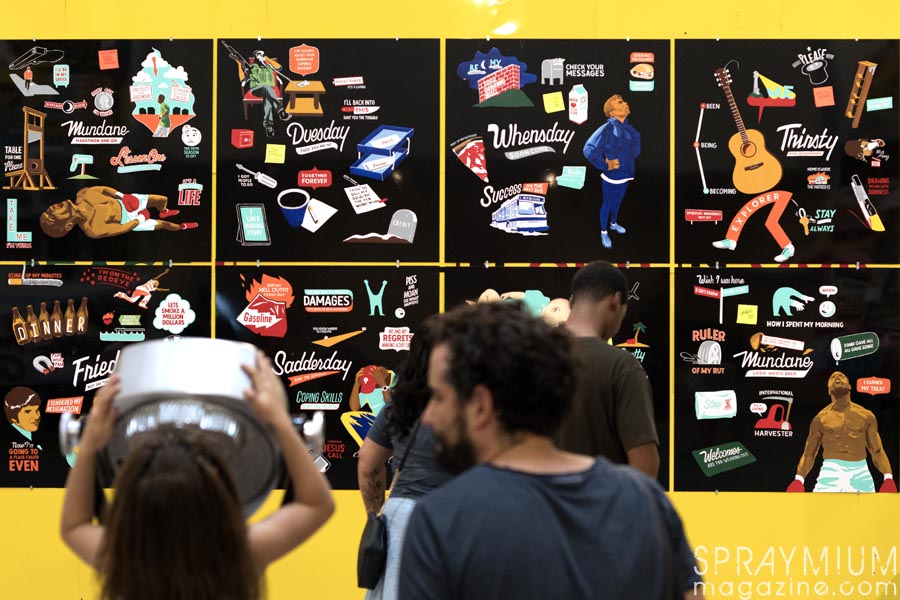Lettres d’amour à la ville.
Le 16 juin dernier, à Besançon. Pour éclairer les interventions d’une quinzaine d’artistes dans l’espace public, le festival Bien Urbain organise ce jour-là une conférence autour de la lettre. Stephen Powers, plébiscité des amateurs de graffiti sous le nom d’Espo, se joint momentanément aux conférenciers. L’Américain, qui n’est que très peu venu peindre en France, est un peu la star de l’édition 2017, et son travail tourne justement autour de l’écriture et la typographie.
Plutôt que de s’asseoir pour dérouler un discours convenu, ce grand bonhomme poupin malgré ses cinquante ans dynamite d’emblée le protocole : de son sourire gourmand, il invite le public à le suivre à l’extérieur, au pied du vaste mur où il peint depuis trois jours à main levée. Dans une palette réduite de rouges, de jaunes, de bleus, de blancs et de noirs, l’artiste présente un assemblage d’expressions françaises et d’anglicismes – sorte de ping-pong linguistique entre Besançon et New York.
C’est devant ce collage hétéroclite de mots et d’images, de dédicaces et de citations qu’Espo prend la parole : « J’ai commencé le graffiti à Philadelphie en 1984, raconte-t-il. Mais ma mère me dit que j’ai vraiment commencé en 1971, à l’âge de trois ans. La seule raison pour laquelle j’ai fait du graffiti était de comprendre qui j’étais. J’ai pris pour nom Espo, qui était une version plus courte, plus rapide, de moi-même. Je pouvais peindre plus vite, je pouvais vivre plus vite, et je pouvais décrire ma vie au rythme où je la vivais. Grâce au graffiti, il me suffit de huit lignes pour vous raconter toute ma vie. » L’égotisme qui fonde la pratique du writing semble pourtant très éloigné de l’œuvre que Stephen Powers est venu créer à Besançon. L’artiste en est conscient, et ajoute aussitôt : « Mais ma vie n’est pas si passionnante. C’est pourquoi j’utilise le pouvoir que me donne la bombe de peinture pour raconter l’histoire de communautés humaines, comme ici à Besançon. Stayhigh 149 (pionnier du graffiti new-yorkais NDLR) avait l’habitude de dire qu’il était la voix du ghetto. Je veux être la voix de tous les autres. »
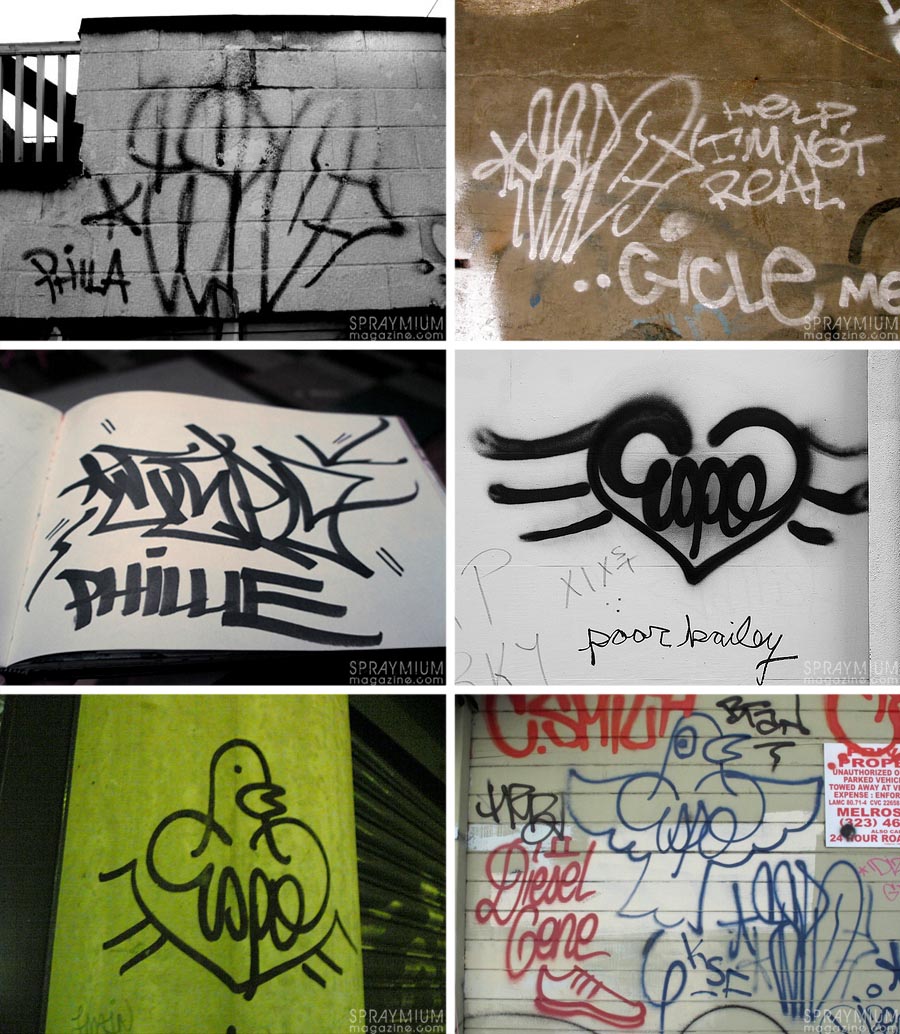
Tags d’Espo 1980’s-2000’s. Photos : Abcdefridays, Wilis Johnson, Elan Wonder, Bomit, Hellabella, KetOne
On pourrait suspecter là de la démagogie : le street art a appris à nous méfier des élans altruistes, rarement plus consistants qu’un plan de carrière. Mais il faut bien reconnaître que le mur d’Espo illustre à la lettre son ambition d’être un porte-voix. Au gré d’allers-retours entre la solitude de la nacelle et la chaleur des échanges noués au pied du mur, il agrège à quelques rares références personnelles tout ce qui flotte dans l’air bizontin : des bribes de conversations, les suggestions des passants, l’empreinte de Victor Hugo sur la ville, celle, plus discrète, de Charles Fourier (autre gloire locale), ou encore les dédicaces aux organisateurs et bénévoles du festival. Quand l’essentiel des artistes urbains intervenant sur commande, dans un cadre légal, tiennent leur support pour une surface à recouvrir intégralement, généralement d’après dessin préparatoire, Stephen Powers procède au contraire par association d’idées, par jeu d’essais et d’erreurs, et ménage sur la paroi autant de pleins que de vides. Si bien qu’il est impossible de prédire, en le regardant peindre, à quoi ressemblera le résultat final.
Cette méthode à rebours du néo-muralisme contemporain, mais qui par un savoureux pied de nez renoue avec la visée émancipatrice dont s’est nourri à l’origine le muralisme, Espo l’éprouve depuis qu’il a délaissé ses oripeaux de graffeur pour une carrière d’artiste. Le tournant date de la fin des années 1990, lorsqu’il quitte Philadelphie, sa ville natale, berceau du graffiti, pour New York. Une façon de tourner le dos à une enfance malheureuse dans une famille nombreuse, catholique et désunie.
La mue d’Espo en Stephen Powers se fait en deux temps. Elle commence par un bilan de l’aventure collective qu’ont été ses années de writing : en juillet 1999, le jeune homme publie The Art of Getting Over. Dans la lignée du magazine de graffiti On The Go, qu’il publiait dans les années 1990, il s’y fait déjà le porte-voix d’une communauté – la sienne. « J’y réfléchissais depuis dix ans, raconte-t-il dans le train qui nous ramène de Besançon à Paris. Je voulais écrire ce livre car l’histoire du graffiti véhiculée par la presse ne reflétait pas la réalité. L’ouvrage m’a autorisé à devenir artiste, dans la mesure où je n’étais plus obligé d’œuvrer de manière illégale. »
Un an après ce coming out, il monte Street Market à la galerie Deitch Projects avec Barry « Twist » Mc Gee et Todd « Reas » James. L’exposition, qui recrée entre quatre murs un environnement urbain fait de boutiques, d’enseignes et de graffitis, lance sa carrière et propulse l’artiste jusqu’à la Biennale de Venise. Mais elle préfigure aussi l’avènement planétaire du street art, avec lequel Stephen Powers prend d’emblée ses distances : « Ça n’est ni tout à fait de la rue, ni tout à fait de l’art », ironise-t-il.
Déjà passé maître dans l’art du pied de nez, le jeune homme choisit plutôt de prendre à rebrousse-poil le virage du graffiti au monde de l’art et s’oriente vers la pratique, artisanale et populaire, du sign painting (peinture d’enseignes). « Je voulais faire quelque chose qui ait l’air d’enseignes, mais qui soit reconnu comme des tableaux, explique-t-il. Ça m’a beaucoup appris sur la peinture. » Il ouvre aussi à New York Icy Signs, sorte de Pop Shop où il commercialise diverses œuvres et produits dérivés en prolongement de ses interventions en tant que sign painter et de ses rares expositions – dont l’une au Brooklyn Museum en 2015-2016.
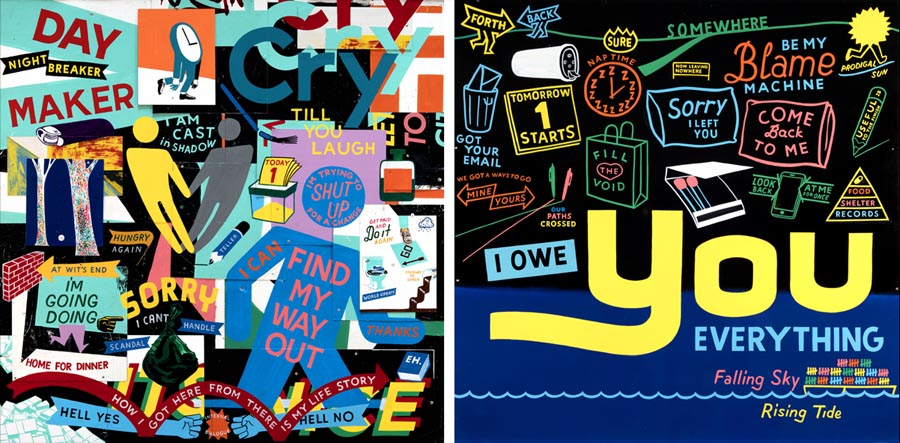
« Cry Till You Laugh » 48″x48″ Enamel on Alumium Collage, 2015 – « I Owe You Everything » Enamel on Alumium, 2015
Dans la lignée de Street Market, Stephen Powers désigne ainsi la communication, sinon la publicité, à la fois comme origine et comme projet du graffiti en général, et de sa démarche en particulier. Il y voit aussi une échappée vers la musique et la poésie, ou l’ « espoetry », comme il aime à dire : « Quand je faisais du graffiti, j’écrivais mon nom des centaines, des milliers de fois, explique-t-il. En devenant artiste, j’ai commencé à m’intéresser à tous les autres mots. » Le sign painting est enfin une manière de conserver un lien avec la rue, avec tout ce que cela implique : la nécessité d’y être clair et concis pour attirer l’attention, mais aussi la responsabilité que confère à l’artiste le fait d’intervenir dans l’espace public. La série des Love Letters, qu’il exécute à Brooklyn, Sao Paulo ou Baltimore, est emblématique du lien affectif que Stephen Powers entretient avec la ville et ses habitants : en une série d’aphorismes à la typographie impeccable, il y engage un dialogue si intime avec son environnement qu’il en devient universel.
Récemment, l’ouverture d’Espo’s Art World à Brooklyn entend ouvrir une nouvelle page dans la carrière du peintre. Dans un lieu qui tient tout à la fois de la galerie et de l’atelier, Stephen Powers y revient à son premier blaze, Espo, comme pour mieux annoncer une nouvelle mue. « Il était temps de revenir à un contact plus direct avec le public, explique-t-il. À Espo’s Art World, les gens peuvent contempler les œuvres, avoir des explications, et même me voir travailler. » Le lieu pourrait aussi marquer un tournant vers un travail qui soit davantage tourné vers l’atelier. « Mon but n’est pas de devenir le meilleur artiste de rue, confie-t-il, mais de faire de meilleures peintures… » Puis il ajoute, dans un ultime pied de nez : « Mais maintenant que tout le monde se dit néo-muraliste, je vais peut-être me définir comme street artist. »
Texte : Stéphanie Lemoine
.
English version:
LOVE LETTERS TO THE CITY
16th of June, Besançon. To highlight the actions of about fifteen artists in the public space, the festival Bien Urbain organises on this day a conference about the letter. Stephen Powers, known and loved by graffiti amateurs by the name of Espo, temporarily joins the speakers. The American, who came very rarely in France to paint, is a bit the star of the 2017 edition, and actually his work deals with writing and typography.
Rather than seating down to give a conventional speech, this tall chubby man, despite his 50 years, dynamites the etiquette : with his generous smile, he invites the audience to follow him outside, at the foot of the big wall where he has been painting freehand for three days. With a colour-range only composed of reds, yellows, blues, whites and blacks, the artist presents a mix of French expressions and Anglicisms – a sort of linguistic Ping-Pong between Besançon and New York.
It’s in front of this eccentric collage of words and images, dedications and quotes, that Stephen Powers takes the floor : « I started graffiti in Philadelphia in 1984, he tells. But my mother says that I really started in 1971, at the age of three. The only reason why I did graffiti was to understand who I was. I took Espo for a name, which was a shorter, quicker version of me. I could paint faster and I could describe my life at the path I was living it. With graffiti, I can tell you my whole life in just eight lines. » The egotism at the basis of the practice of writing seems to be really far from the work Stephen Powers came to create in Besançon. The artist is aware of it, and adds right away : « But my life is not so fascinating. That’s why I use the power that the spray can gives me to tell the history of human communities like here in Besançon. Stayhigh 149 (ed. pionneer of the graffiti writing in New York) used to say he was the voice of the ghetto. I want to be the voice of all the other ones. »
We could suspect some demagogy here : street art taught us not to trust altruistic bursts rarely more than a career plan. But one has to admit that Espo’s wall sticks to the letter to his ambition to be a spokesperson. As he goes back and forth from the loneliness of the platform lift to the warmth of the discussion started at the foot of the wall, he adds to some scarce personal references everything that is in the air of Besançon : extracts of talks, suggestions of passers-by, the mark of Victor Hugo on the city, the more discreet one of Charles Fournier (the other local star), or the dedications to the organisers and volunteers of the festival. When most commissioned urban artists, in legal circumstances, see the support as a surface to cover entirely, generally after a prepara- tory design, on the contrary Stephen Powers works with association of ideas, games of tries and mistakes, and leaves on the wall as many covered spaces as empty ones. So that looking at him painting, it is impossible to foretell what the final result will look like.
This method at odds with the contemporary neo-muralism, but which through a delicious jest takes up the emancipating aim at the root of muralism, Espo has been testing it since he quit his graffiti artist rags to start an artistic career. The turning point was in the late 1990s when he left Philadelphia, his birthcity, cradle of graffiti, for New York. A way to turn his back to a sad childhood in a large divided catholic family. Espo’s metamorphosis into Stephen Powers happened in two times. It started with the assessment of the collective adventure that were his writing years : in July 1999, the young man published The Art of Getting Over. In line with the graffiti magazine On The Go, that was published in the 1990s, he already gives a voice to a community – his own. « I thought about it for ten years, he recalls in the train that takes us back from Besançon to Paris. I wanted to write this book because the history of graffiti conveyed by the press did not reflect the reality. The book allowed me to become an artist as I did not have to work illegally anymore. »
One year after this coming out, he sets up Street Market at the Deitch Projects gallery with Barry « Twist » Mc Gee and Todd « Reas » James. The exhibition that recreates between four walls an urban environment made of shops, signs and graffiti, launches his career and propels him at the Venice Biennale. But it also foreshadows the world coming of street art, from which Stephen Powers immediately distances himself : « It is neither completely street, nor completely art », he says with irony.
Already a master of mockery, the young man rather chooses to take the shift from graffiti to the art world in the opposite way and turns himself towards the popular and handmade practice of sign painting. « I wanted to do something that would look like signs, but that would be acknowledged as paintings, he explains. It taught me a lot on paintings. » He also opens Icy Signs in New York, a kind of Pop Shop where he sells various works and by-products from his actions as a sign painter and his rare shows – including one in the Brooklyn Museum in 2015-2016.
In line with Street Market, Stephen Powers thus sees communication, or not to say advertising, both as the root and project of graffiti in general and of his approach in particular. He also sees in it a way out towards music and poetry or « espoetry » as he likes to call it : « When I was doing graffiti, I was writing my name hundreds, thousands of times, he explains. Becoming an artist I started paying attention to other words. » Sign painting is eventually a way to keep a link with the street and all it involves : the need to be clear and short to catch the attention, but also the responsibility that is given to the artist when he acts. The Love Letters series that he created in Brooklyn, Sao Paolo or Baltimore, is the symbol of the affective connection Stephen Powers maintains with the city and its inhabitants : in a series of aphorisms with a perfect typography, he starts a dialogue so intimate with his environment that it becomes universal.
Lately, the opening of Espo’s Art World in Brooklyn aims at writing a new page in the painter’s career. In a place that is both a gallery and a studio, Stephen Powers takes back his first alias, Espo, as to announce a new metamorphosis. « It was time to come back to a more direct contact with the public, he explains. At Espo’s Art World, people can contemplate works, get explanations and even watch me working. » The place could also mark a turning point towards a work that would head more towards studio. « My goal is not to become the best street artist, he confides, but to create better paintings… » Then in a last jest he adds : « But now that everybody calls himself neo-muralist, I will maybe define myself as a street artist. »
